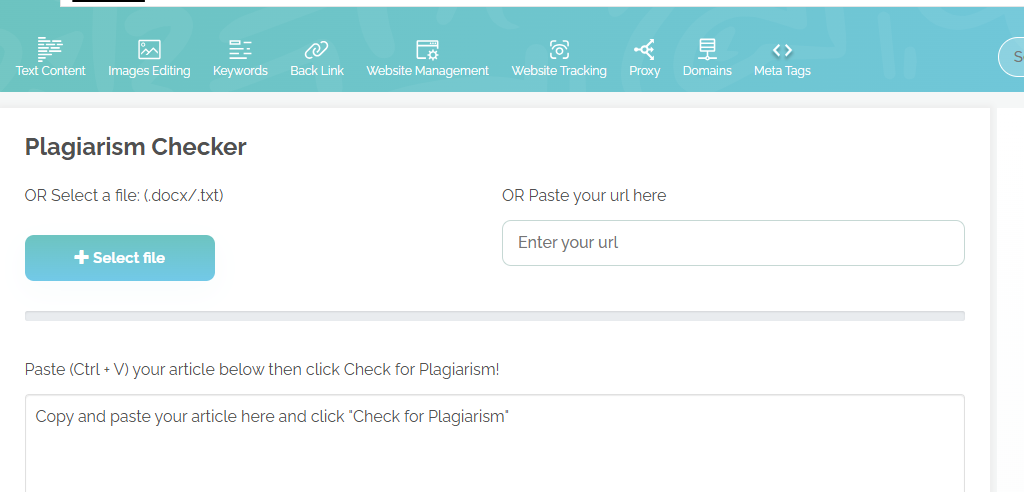Plagiarism Checkers for Students and Academics: A Comprehensive Guide
In the realm of education and research, the importance of originality and integrity cannot be overstated. As students, academics, and researchers, producing unique and innovative work is essential not only for personal development but also for the advancement of knowledge. However, in today’s digital age, with vast amounts of information available online, unintentional plagiarism has become a growing concern. Fortunately, plagiarism checker is now an invaluable tool for students and academics alike to ensure their work remains original and adheres to ethical standards.
In this blog post, we will explore what plagiarism is, why it matters, and how plagiarism checkers function. We will also review some of the most popular plagiarism detection tools available for students and academics, their features, benefits, and limitations. By the end of this article, you will have a thorough understanding of plagiarism checkers and how they can help you maintain academic integrity.
What Is Plagiarism?
Plagiarism is the act of using someone else’s work, ideas, or intellectual property without proper acknowledgment. This can occur in various forms, such as copying text verbatim, paraphrasing without citation, or presenting someone else’s work as your own. In academic settings, plagiarism can lead to severe consequences, ranging from failing assignments to expulsion in extreme cases.
Plagiarism is not limited to just written work. It can also occur with other forms of intellectual property, such as images, music, code, and data. With the ease of access to online content, the chances of inadvertent plagiarism have increased, making it necessary for students and researchers to be vigilant about ensuring proper citation and originality.
Why Is Plagiarism Important?
Plagiarism undermines the trust that forms the foundation of the academic and research community. It is essential for students and academics to develop critical thinking skills and to contribute original knowledge rather than simply copying the work of others. Ethical writing practices ensure that creators are given credit for their work, and that knowledge is appropriately shared and built upon.
In addition to ethical considerations, plagiarism has serious academic and legal consequences. Institutions have strict policies and codes of conduct to maintain academic integrity, and plagiarism can lead to failing grades, suspension, or even legal action in cases of copyright infringement. Thus, ensuring that your work is free of plagiarism is crucial for maintaining a good academic standing and a reputable research career.
The Role of Plagiarism Checkers
Plagiarism checkers are tools designed to detect instances of plagiarism in written content. They analyze text for similarities with existing sources, such as academic papers, books, journals, websites, and other publications. These tools are capable of identifying exact matches as well as paraphrased sections of text. By providing students and academics with detailed reports, plagiarism checkers help users pinpoint potential issues before submitting their work.
Plagiarism checkers can also serve as a preventive measure. By running a document through a plagiarism checker, students and academics can identify any unintentional plagiarism early, allowing them to make necessary revisions and cite sources appropriately.
How Plagiarism Checkers Work
Plagiarism checkers operate by comparing the submitted text against a vast database of online sources, academic journals, publications, and other texts. The process generally involves the following steps:
- Text Submission: The user uploads or pastes the text they want to check into the plagiarism checker.
- Text Analysis: The plagiarism checker scans the text and identifies patterns, phrases, or passages that resemble content from its database.
- Report Generation: The tool generates a detailed report, highlighting the portions of the text that match other sources. The report often includes the source of the matched content, along with a similarity score or percentage.
- Suggestions for Improvement: Some plagiarism checkers offer suggestions on how to properly cite sources or rewrite the identified sections to improve originality.
While some plagiarism checkers are capable of scanning only publicly available content, others are integrated with academic databases like JSTOR, Google Scholar, and proprietary repositories, allowing for a more thorough check.
Popular Plagiarism Checkers for Students and Academics
Several plagiarism checkers are available for students and academics, each with varying features, accuracy, and pricing. Let’s take a look at some of the most popular ones.
1. Turnitin
Turnitin is arguably the most well-known and widely used plagiarism detection tool in academic circles. It is primarily used by universities, colleges, and educational institutions to ensure the originality of student submissions.
Features:
- Comprehensive Database: Turnitin compares submissions to a vast database of student papers, journals, books, and websites.
- Detailed Reports: The tool provides a similarity report that highlights potential instances of plagiarism and the sources where the content was found.
- Integration with Learning Management Systems (LMS): Turnitin integrates seamlessly with platforms like Moodle, Blackboard, and Canvas, making it easy for instructors to check papers.
- Feedback Tools: Turnitin offers tools for instructors to provide feedback on student work, making it a valuable platform for both plagiarism detection and academic development.
Benefits:
- Trusted by many educational institutions for its reliability.
- Comprehensive matching with academic papers, websites, and student submissions.
- In-depth reporting helps instructors identify plagiarism trends in student work.
Limitations:
- Turnitin is not freely available to individual users, and is typically only accessible through academic institutions.
- It may not catch non-text-based plagiarism, such as images or datasets.
2. Grammarly
Grammarly is best known for its grammar and writing enhancement features, but it also offers a plagiarism checker as part of its premium subscription. Grammarly’s plagiarism detection tool is aimed at students, professionals, and casual users who want to ensure their work is free from plagiarism.
Features:
- Real-Time Plagiarism Check: Grammarly scans your text for plagiarism in real time, flagging potential issues as you write.
- Database: It checks the text against billions of web pages to find matches.
- Writing Suggestions: Apart from plagiarism detection, Grammarly provides recommendations for improving the clarity, style, and tone of the writing.
Benefits:
- Convenient, with real-time feedback while writing.
- Offers suggestions to improve both writing quality and originality.
- Easy-to-use interface and integrations with popular word processors like Microsoft Word and Google Docs.
Limitations:
- Grammarly’s plagiarism checker is available only with the premium subscription, which can be expensive for students.
- Its database is not as extensive as some specialized academic tools like Turnitin.
3. Copyscape
Copyscape is a plagiarism detection tool that is primarily focused on checking online content. It is popular among bloggers, content creators, and those who publish content on the web.
Features:
- Online Content Search: Copyscape checks for plagiarism by comparing the submitted text against published web content.
- Premium Plan: The premium version allows users to check entire documents and provides detailed reports.
- Batch Search: This feature allows users to check multiple documents at once, which is useful for businesses and large organizations.
Benefits:
- Affordable and widely used by content creators for web-based plagiarism checks.
- Easy to use, with a straightforward interface.
- Provides detailed results with links to matching content on the web.
Limitations:
- Primarily designed for online content, so it may not be as effective for academic papers or non-web-based sources.
- The free version offers limited functionality, and the premium plan can be expensive for casual users.
4. Plagscan
Plagscan is another plagiarism detection tool used by both students and professionals. It is known for its accuracy and ease of use, providing detailed plagiarism reports.
Features:
- Comprehensive Search: Plagscan checks submissions against a vast database of academic journals, websites, and other scholarly content.
- Customizable Reports: Users can tailor the plagiarism reports to highlight specific sources or exclude certain matches.
- Integration: Plagscan integrates with learning management systems, making it ideal for educational institutions.
Benefits:
- Excellent for academic papers, as it checks scholarly sources extensively.
- Detailed reports that help users understand the degree of plagiarism and how to correct it.
- Flexible pricing based on the number of words checked.
Limitations:
- Not as widely used or recognized as Turnitin in academic circles.
- Some users report slower processing times for large documents.
5. Quetext
Quetext offers both a free and premium version of its plagiarism checker. It is an excellent tool for students and researchers who need a simple yet effective plagiarism detection tool.
Features:
- DeepSearch Technology: The premium version uses advanced algorithms to detect plagiarism even in paraphrased text.
- Citation Assistant: Helps users properly cite sources, reducing the risk of unintentional plagiarism.
- Color-Coded Reports: Matches are highlighted in different colors for easy identification.
Benefits:
- Free version is available, offering a basic level of plagiarism detection.
- Simple interface and easy-to-understand reports.
- Provides suggestions for properly citing sources.
Limitations:
- The free version has limited functionality and a word count cap.
- Some advanced features, like detailed database searching, are only available in the premium version.
6. Plagiarism Checker by Small SEO Tools
Small SEO Tools offers a free plagiarism checker that is accessible to anyone, making it a good choice for students on a budget.
Features:
- Free and Easy to Use: The plagiarism checker is free to use with no sign-up required.
- Text and URL Checking: Users can either paste their text into the tool or check for plagiarism using a URL.
- Word Limit: The free version allows users to check up to 1,000 words at a time.




